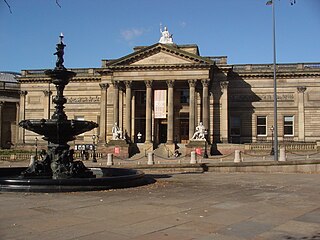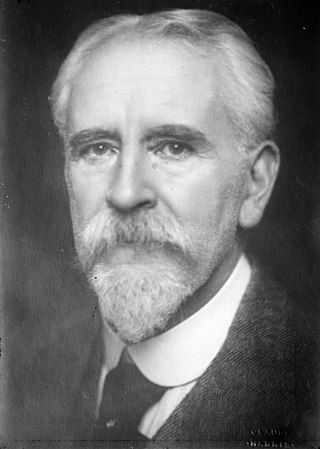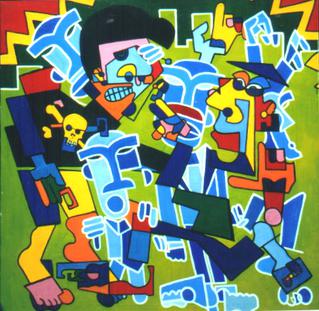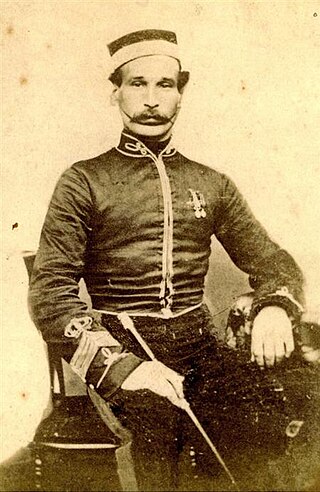
The Ashmolean Museum of Art and Archaeology on Beaumont Street, Oxford, England, is Britain's first public museum. Its first building was erected in 1678–1683 to house the cabinet of curiosities that Elias Ashmole gave to the University of Oxford in 1677. It is also the world's second university museum, after the establishment of the Kunstmuseum Basel in 1661 by the University of Basel.

The National Gallery is an art museum in Trafalgar Square in the City of Westminster, in Central London, England. Founded in 1824, in Trafalgar Square since 1838, it houses a collection of over 2,300 paintings dating from the mid-13th century to 1900. The current Director of the National Gallery is Gabriele Finaldi.

Sir John Everett Millais, 1st Baronet was an English painter and illustrator who was one of the founders of the Pre-Raphaelite Brotherhood. He was a child prodigy who, aged eleven, became the youngest student to enter the Royal Academy Schools. The Pre-Raphaelite Brotherhood was founded at his family home in London, at 83 Gower Street. Millais became the most famous exponent of the style, his painting Christ in the House of His Parents (1849–50) generating considerable controversy, and he produced a picture that could serve as the embodiment of the historical and naturalist focus of the group, Ophelia, in 1851–52.

The Pre-Raphaelite Brotherhood was a group of English painters, poets, and art critics, founded in 1848 by William Holman Hunt, John Everett Millais, Dante Gabriel Rossetti, William Michael Rossetti, James Collinson, Frederic George Stephens and Thomas Woolner who formed a seven-member "Brotherhood" partly modelled on the Nazarene movement. The Brotherhood was only ever a loose association and their principles were shared by other artists of the time, including Ford Madox Brown, Arthur Hughes and Marie Spartali Stillman. Later followers of the principles of the Brotherhood included Edward Burne-Jones, William Morris and John William Waterhouse.

The Ruskin Pottery was an English art pottery studio founded in 1898 by Edward R. Taylor, the first principal of both the Lincoln School of Art and the Birmingham School of Art, to be run by his son, William Howson Taylor, formerly a student there. It was named after the artist, writer and social thinker John Ruskin, as the Taylors agreed with, and followed the tenets of Ruskin. The pottery was situated at 173-174 Oldbury Road, Smethwick, then in Staffordshire.

The Walker Art Gallery is an art gallery in Liverpool, which houses one of the largest art collections in England outside London. It is part of the National Museums Liverpool group.

The William Morris Gallery is a museum devoted to the life and works of William Morris, an English Arts and Crafts designer and early socialist. It is located in Walthamstow at Water House, a substantial Grade II* listed Georgian home. The extensive grounds of the building are a public park, known as Lloyd Park.

The Speed Art Museum, originally known as the J.B. Speed Memorial Museum, now colloquially referred to as the Speed by locals, is the oldest and largest art museum in Kentucky. It was established in 1927 in Louisville, Kentucky on Third Street next to the University of Louisville Belknap campus. It receives around 180,000 visits annually.

Wolverhampton Art Gallery is located in the City of Wolverhampton, in the West Midlands, United Kingdom. The building was funded and constructed by local contractor Philip Horsman (1825–1890), and built on land provided by the municipal authority. It opened in May 1884.

The Stuckists Punk Victorian was the first national gallery exhibition of Stuckist art. It was held at the Walker Art Gallery and Lady Lever Art Gallery in Liverpool from 18 September 2004 to 20 February 2005 and was part of the 2004 Liverpool Biennial.

John Bourne is a British artist and painter, living and working in Wales, and a member of the Stuckists art movement. He founded the Wrexham Stuckists group in 2001 and has been exhibited in the group's shows since then, including The Stuckists Punk Victorian. He has also taken part in Stuckist demonstrations against the Turner Prize. The subject matter for his paintings, which are done in a simplified style, comes from his memories.

Sir Francis Bernard Dicksee was an English Victorian painter and illustrator, best known for his pictures of dramatic literary, historical, and legendary scenes. He also was a noted painter of portraits of fashionable women, which helped to bring him success in his own time.

Regan Tamanui is an artist based in Melbourne, Australia. In October 2000, he founded the Melbourne Stuckists, the fourth Stuckist of the original Stuckist groups and the first outside the United Kingdom. He has also painted prolifically as a street artist under the tag name HA-HA.
Naive John is a British artist and figurative painter. His work shows attention to detail with subjects that combine elements from popular culture alongside the mythic and mundane. He has also in the past been involved in the Stuckism art movement.

The Huntington Museum of Art is a nationally accredited art museum located in the Park Hills neighborhood above Ritter Park in Huntington, West Virginia. Housed on over 50 acres of land and occupying almost 60,000 square feet, it is the largest art museum in the state of West Virginia. The museum's campus is home to nature trails and the C. Fred Edwards Conservatory, a subtropical and tropical plant conservatory. The museum's collection includes American and European paintings, sculptures, prints, and drawings, as well as glass pieces manufactured in West Virginia and the Ohio Valley, American folk art, Chinese and Japanese decorative objects, Haitian art, firearms, and decorative arts from the Near East. In addition to its permanent collections, the museum hosts traveling exhibitions and houses the James D. Francis Art Research Library, the Grace Rardin Doherty Auditorium, and five art studios where artists in residence are periodically hosted and classes are held. The Huntington Museum of Art holds one of the largest collections of art in the state of West Virginia.

Sir Nicholas Serota Makes an Acquisitions Decision is one of the paintings that was made as a part of the Stuckism art movement, and is recognized as a "signature piece" for the movement, It was painted by the Stuckism co-founder Charles Thomson in 2000, and has been exhibited in a number of shows since, as well as being featured on placards during Stuckist demonstrations against the Turner Prize.

Abbot Hall Art Gallery is an art gallery in Kendal, England. Abbot Hall was built in 1759 by Colonel George Wilson, the second son of Daniel Wilson of Dallam Tower, a large house and country estate nearby. It was built on the site of the old Abbot's Hall, roughly where the museum is today. Before the Dissolution of the Monasteries this was where the Abbot or his representative would stay when visiting from the mother house of St Mary's Abbey, York. The architect is unknown. During the early twentieth century the Grade I listed building was dilapidated and has been restored as an art gallery.

Joanna Mary Boyce was a British painter associated with the Pre-Raphaelite Brotherhood. She is also known by her married name as Mrs. H.T. Wells, or as Joanna Mary Wells. She produced multiple works with historical themes, as well as portraits and sketches, and authored art criticism responding to her contemporaries. She was the sister of Pre-Raphaelite watercolourist George Price Boyce.

Alderman John Ashley Kilvert (1833–1920) was an English soldier and later businessman and politician, who became Mayor of Wednesbury, then in Staffordshire, England. He served as a cavalryman with the 11th Hussars in the Crimean War, where he survived the Charge of the Light Brigade. His medals are displayed at Wednesbury Museum and Art Gallery.

Joseph Gibbs was a portrait painter who worked in the area around Smethwick, then South Staffordshire, England, during the period 1852 to 1907.






















